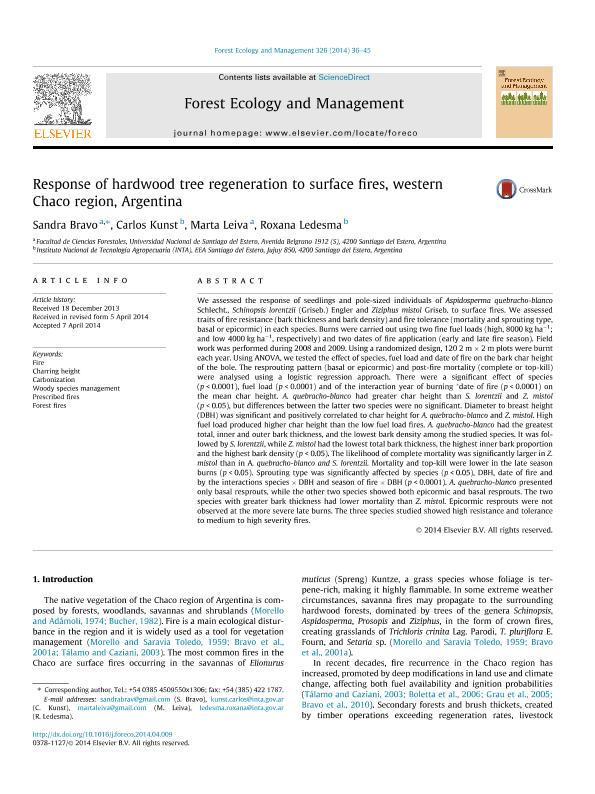Artículo
Response of hardwood tree regeneration to surface fires, western Chaco region, Argentina
Fecha de publicación:
05/2014
Editorial:
Elsevier
Revista:
Forest Ecology and Management
ISSN:
0378-1127
Idioma:
Inglés
Tipo de recurso:
Artículo publicado
Clasificación temática:
Resumen
We assessed the response of seedlings and pole-sized individuals of Aspidosperma quebracho-blanco Schlecht., Schinopsis lorentzii (Griseb.) Engler and Ziziphus mistol Griseb. to surface fires. We assessed traits of fire resistance (bark thickness and bark density) and fire tolerance (mortality and sprouting type, basal or epicormic) in each species. Burns were carried out using two fine fuel loads (high, 8000 kg ha−1; and low 4000 kg ha−1, respectively) and two dates of fire application (early and late fire season). Field work was performed during 2008 and 2009. Using a randomized design, 120 2 m × 2 m plots were burnt each year. Using ANOVA, we tested the effect of species, fuel load and date of fire on the bark char height of the bole. The resprouting pattern (basal or epicormic) and post-fire mortality (complete or top-kill) were analysed using a logistic regression approach. There were a significant effect of species (p < 0.0001), fuel load (p < 0.0001) and of the interaction year of burning *date of fire (p < 0.0001) on the mean char height. A. quebracho-blanco had greater char height than S. lorentzii and Z. mistol (p < 0.05), but differences between the latter two species were no significant. Diameter to breast height (DBH) was significant and positively correlated to char height for A. quebracho-blanco and Z. mistol. High fuel load produced higher char height than the low fuel load fires. A. quebracho-blanco had the greatest total, inner and outer bark thickness, and the lowest bark density among the studied species. It was followed by S. lorentzii, while Z. mistol had the lowest total bark thickness, the highest inner bark proportion and the highest bark density (p < 0.05). The likelihood of complete mortality was significantly larger in Z. mistol than in A. quebracho-blanco and S. lorentzii. Mortality and top-kill were lower in the late season burns (p < 0.05). Sprouting type was significantly affected by species (p < 0.05), DBH, date of fire and by the interactions species × DBH and season of fire × DBH (p < 0.0001). A. quebracho-blanco presented only basal resprouts, while the other two species showed both epicormic and basal resprouts. The two species with greater bark thickness had lower mortality than Z. mistol. Epicormic resprouts were not observed at the more severe late burns. The three species studied showed high resistance and tolerance to medium to high severity fires.
Archivos asociados
Licencia
Identificadores
Colecciones
Articulos(SEDE CENTRAL)
Articulos de SEDE CENTRAL
Articulos de SEDE CENTRAL
Citación
Bravo, Sandra; Ledesma, Roxana; Leiva, Marta Elisabeth; Kunst, Carlos Roberto Guillermo; Response of hardwood tree regeneration to surface fires, western Chaco region, Argentina; Elsevier; Forest Ecology and Management; 326; 0; 5-2014; 36-45
Compartir
Altmétricas




